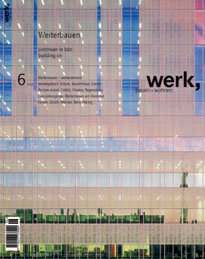Editorial
Editorial
Building is always „building on“. Building on in situ, building onto existing buildings. Most of the examples cited in this issue are interventions on buildings that were deemed worthy of preservation first of all for practical reasons to do with economics, building regulations or deadlines. Our particular interest concerned cases where architectural considerations also played a part - or where they emerged during the design process. In fact, it is frequently the interference with the existing building that gives rise to an architectural complexity which, on virgin building sites, may only be achieved through considerable artistry on the part of the designer. And even commonplace old buildings are often endowed with atmospheric, technical or spatial qualities that would scarcely develop in a new building. „Building on“ averts the danger, as Francesco Collotti asserts, of „a-topia“ by necessitating an analysis of the concrete place and its history, as may illustrate the five almost commonplace examples at the beginning of this issue. The situation regarding buildings with historical significance, where the practical and architectural reasons for building on are outweighed by conservational considerations, is somewhat different. Here, the intervention of the monument curator, playing the part of an advocate for historical awareness, complements the - often opposing - perspective of the architect. In short, whereas the architect's future-orientated eye detects the present in the old, the monument curator sees the witness of a past that is worthy of preservation. This reductive formula has its own history in the development of modernity, and its consequences have been far-reaching: on the one hand we observe a fixation on the new, on the other the embalment of the life-alienated monument. And often enough, it encourages an unsatisfactory juxtaposition of glaringly contrasting interventions to plainly restored buildings. The requirements of historical truth on the one hand and aesthetic truth on the other must, however, be negotiated, no matter how hard this may be. Thus Thomas Will and Nott Caviezel both postulate a discursive rather than a normative approach in dealing with monuments. Following the trench warfare of modernity, we could now „try out the radical freedom that permits not only the discovery of the new but also the continuation - the building onto - of the old“ as Thomas Will puts it in his article. Building on that adapts to the existing object with respect but without awe and which preserves the old by retaining it in the new. It is conceivable that a new tradition could develop from this approach, something that has often been vainly attempted during the last century.
The editors
